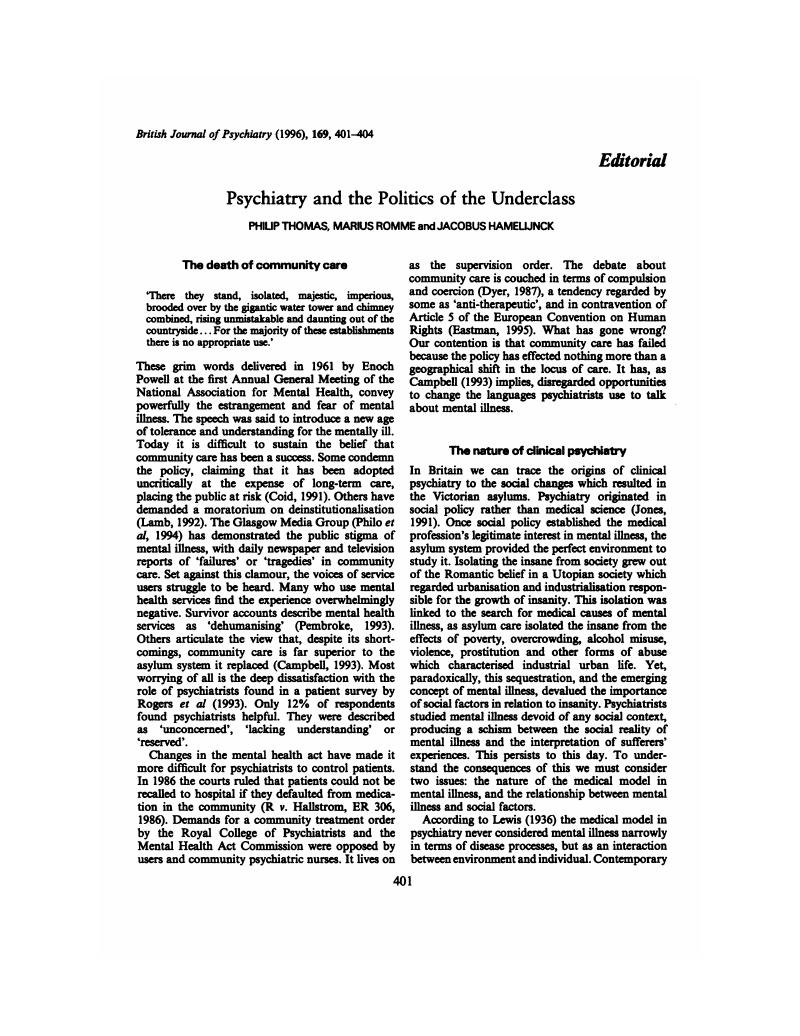Crossref Citations
This article has been cited by the following publications. This list is generated based on data provided by Crossref.
Seneviratne, S.
1997.
[No Title].
British Journal of Psychiatry,
Vol. 170,
Issue. 2,
p.
191.
Shaw, M.
1997.
Psychiatry and the politics of the underclass.
British Journal of Psychiatry,
Vol. 170,
Issue. 2,
p.
191.
Kraemer, S.
and
Roberts, J.
1997.
[No Title].
British Journal of Psychiatry,
Vol. 170,
Issue. 2,
p.
191.
Greenberg, M.
1997.
[No Title].
British Journal of Psychiatry,
Vol. 170,
Issue. 2,
p.
191.
Thomas, P.
and
Romme, M.
1997.
Authors' reply.
British Journal of Psychiatry,
Vol. 170,
Issue. 2,
p.
192.
Culliford, L.
1997.
[No Title].
British Journal of Psychiatry,
Vol. 170,
Issue. 2,
p.
191.
McCubbin, Michael
and
Weisstub, David N.
1998.
Toward a Pure Best Interests Model of Proxy Decision Making for Incompetent Psychiatric Patients.
International Journal of Law and Psychiatry,
Vol. 21,
Issue. 1,
p.
1.
Thomas, Phil
1998.
Writing letters to patients.
Psychiatric Bulletin,
Vol. 22,
Issue. 9,
p.
542.
Crawford, M.
and
Davies, S.
1998.
Involvement of users and carers in the training of psychiatrists: making it happen.
Psychiatric Bulletin,
Vol. 22,
Issue. 1,
p.
42.
Williams, Brian
Cattell, Dinah
Greenwood, Mike
LeFevre, Sharon
Murray, Ian
and
Thomas, Phil
1999.
Exploring ‘person-centredness’: user perspectives on a model of social psychiatry.
Health & Social Care in the Community,
Vol. 7,
Issue. 6,
p.
475.
Mitchison, Sally
1999.
The value of eliciting dreams in general psychiatry.
Advances in Psychiatric Treatment,
Vol. 5,
Issue. 4,
p.
296.
Crawford, Mike
2001.
Involving users in the development of psychiatric services – no longer an option.
Psychiatric Bulletin,
Vol. 25,
Issue. 3,
p.
84.
Cooper, Brian
2001.
Nature, nurture and mental disorder: old concepts in the new millennium.
British Journal of Psychiatry,
Vol. 178,
Issue. S40,
p.
s91.
Nagel, Tricia
2003.
Involuntary Mental Health Treatment in the Remote Northern Territory.
Psychiatry, Psychology and Law,
Vol. 10,
Issue. 1,
p.
171.
Santiago Delefosse, Marie
2011.
Actualité de la pensée critique en psychologie de la santé somatique et mentale dans le monde anglo-saxon.
Bulletin de psychologie,
Vol. Numéro 511,
Issue. 1,
p.
5.
Santiago Delefosse, M.
Gonin Nicole, A.
and
Sautter, C.S.
2011.
Naissance d'une psychiatrie critique anglo-saxonne, perspectives et limites.
EMC - Psychiatrie,
Vol. 8,
Issue. 1,
p.
1.
Lake, James H.
2019.
An Integrative Paradigm for Mental Health Care.
p.
127.
Argolo, Felipe
Magnavita, Guilherme
Mota, Natalia Bezerra
Ziebold, Carolina
Mabunda, Dirceu
Pan, Pedro M.
Zugman, André
Gadelha, Ary
Corcoran, Cheryl
and
Bressan, Rodrigo A.
2020.
Lowering costs for large-scale screening in psychosis: a systematic review and meta-analysis of performance and value of information for speech-based psychiatric evaluation.
Brazilian Journal of Psychiatry,
Vol. 42,
Issue. 6,
p.
673.
Lake, James H.
2024.
Integrative psychische Gesundheitsversorgung.
p.
151.




eLetters
No eLetters have been published for this article.